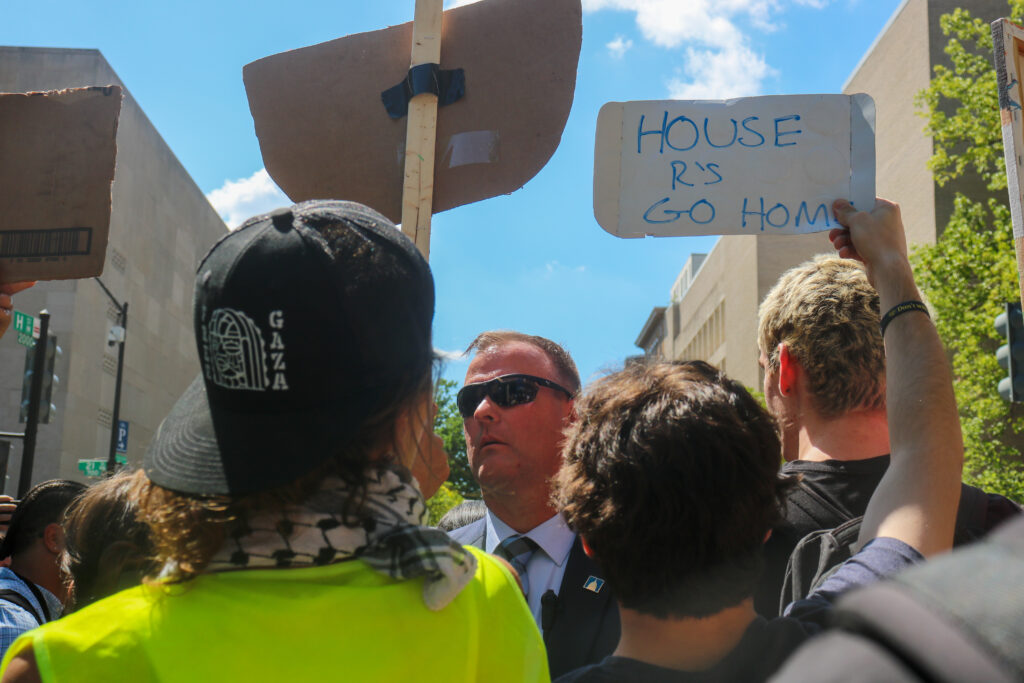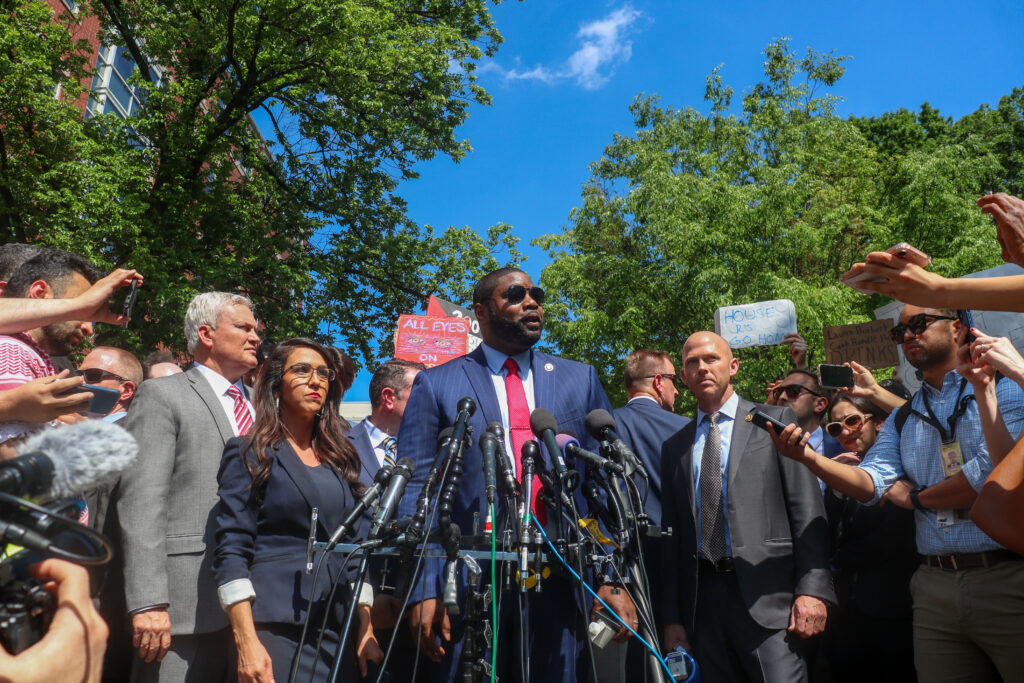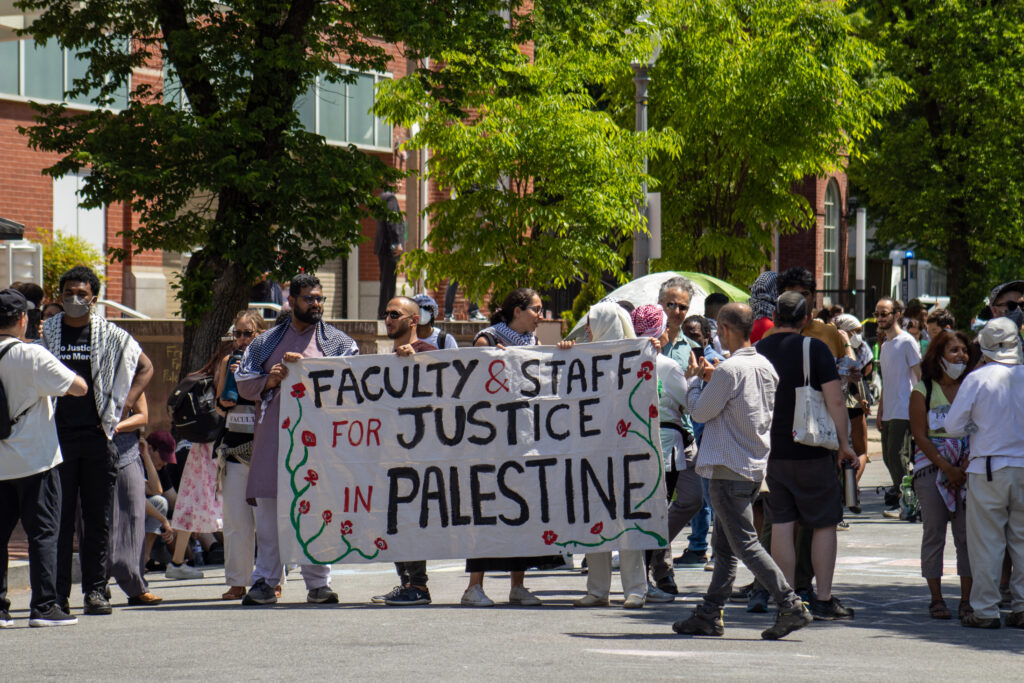Over a week ago, a coalition of students from universities across D.C., including Georgetown, George Washington University (GW), and American University, established a Gaza solidarity encampment at University Yard (U-Yard) on GW’s campus.
The encampment—like others around the country—is in protest of Israel’s ongoing occupation of Palestine and its bombardment of the Gaza Strip, where the International Court of Justice has ruled that Israel “plausibly violated” the U.N. genocide convention.
Since its establishment on April 25, the encampment, which protesters have named the “popular university for Gaza,” has expanded to include over 60 tents, spanning the entirety of quad, as well as the 2000 block of H street. It has received support in the form of supply donations from outside community members and hosted rallies with crowds of 600 or more. Protesters plan to stay at the encampment indefinitely until their demands are met.
While the encampment has brought together students, academics, and community members from across D.C., it has also garnered national attention. The last three days have seen a flurry of activity, including visits and condemnations from congressional Republicans, a counter rally, and contentions over which flag should fly over U-Yard.
Wednesday, May 1: Congressional Republicans visit encampment
D.C. Mayor Muriel Bowser’s decision to decline GW’s request for a police sweep of the encampment on April 26 has been met with praise from organizers and harsh criticism from opponents, including several Republican members of the House Committee on Oversight and Accountability. As a result, the committee announced that it will hold a hearing on May 8, titled “Oversight of D.C.’s Response to Unlawful Activity and Antisemitism,” where both Bowser and MPD Chief Pamela Smith will be called to testify about the decision.
In preparation for the hearing, Republican members of the committee visited the encampment on May 1. Members, including Chairman James Comer (R-Ky.) and Representatives Lauren Boebert (R-Colo.), Anna Paulina Luna (R-Fla.), Byron Donalds (R-Fla.), Eric Burlison (R-Mo.), and William Timmons (R-S.C.) met with GW officials as well as students and held a press conference on H Street in front of the encampment.
 Eddy Binford-Ross for The Georgetown Voice
Eddy Binford-Ross for The Georgetown Voice
During the visit, the Voice witnessed Boebert attempt to pull a Palestinian flag off of a statue of George Washington in U-Yard, while yelling at organizers, among them students and faculty, “This is America, and that shit needs to come down.” Boebert then argued with several demonstrators before being escorted away by her security.
During the press conference, several of the representatives called for removal of the encampment, citing public safety concerns. They also called for the arrest of anyone breaking the law, including students.
“We expect these encampments to be cleared out,” Comer said at the press conference. “I can see how disruptive this is to an everyday student.”
 Eddy Binford-Ross for The Georgetown Voice
Eddy Binford-Ross for The Georgetown Voice
Student organizers expressed disappointment in the reaction to the encampments, both in D.C. and across the country. At Columbia University and other schools across the country, students have been violently arrested or attacked by counter-protesters.
“I think it’s shameful that our lawmakers are more ready and more willing to brutalize college students, to put college students in harm’s way, than they are to fight against genocide and to condemn genocide,” Miriam Siegel (SFS ’26), an organizer who has been at the encampment since the first day, said.
GW organizers also share this sentiment, but emphasized their belief in the power of numbers and solidarity.
“The images coming out of other campuses are obviously disturbing, but I have so much faith in the student body and the power we have as a collective,” Maria, a student organizer at GW who spoke to the Voice on the condition that she be identified only by her first name, said.
 Eddy Binford-Ross for The Georgetown Voice
Eddy Binford-Ross for The Georgetown Voice
Thursday, May 2: Simultaneous protest and counter-protest
Late Thursday morning, the Gaza solidarity encampment and GW for Israel, a student organization at GW, held simultaneous rallies two blocks from each other. Around 500 people were at the encampment and around 250 to 300 gathered at G Street Park, just a couple blocks away, for the pro-Israel counter-protest.
Organizers at both the protest and counter-protest asked the crowd not to engage with participants of the other demonstration, and the events remained separate for their entire duration.
A coalition of faculty and staff from participating universities who support the encampment, stood in a line at the entrance of H Street from 21 St, between the protest and counter-protest. Members of the group, who have formed human chains around the encampment on multiple occasions throughout the last week, stressed the importance of community safety.
 Katie Doran for The Georgetown Voice
Katie Doran for The Georgetown Voice
“We’re just here to make sure that the atmosphere at the encampment stays positive, and that in the very, very small likelihood something happens that faculty are here to hopefully provide a kind of shield between students and whatever trouble may be coming down the road,” Crystal Luo, a Georgetown faculty member, said.
Three people held up a painted banner in Arabic which read: “Carrying, Rafah, Gaza, All of Palestine. You are our compass. You are our reason. Until complete liberation, the students are for justice in Palestine.” While others listened to speakers who described messages they had received from people in Gaza thanking students for protesting at the GW encampment.
 Sydney Carroll for The Georgetown Voice
Sydney Carroll for The Georgetown Voice
“These people’s conditions are a billion times worse than ours. And they still took time out of their day to make a banner thanking us,” a student speaker from Gallaudet University said. “So, our lovely students in here, sat outside and painted this banner together as a response to Rafah, as a thank you and as a promise that we will continue to stay steadfast for them, and we will not leave until we are physically removed.”
At the same time, the counter-protest was beginning. The event was organized by students from groups including GW for Israel, the GW Jewish Student Association, Students Supporting Israel from AU, and the Israeli American Council from the University of Maryland.
The speeches touched on Zionism, Jewish pride, and the need to combat antisemitism. Zionism is defined by Harvard University’s pluralism project as the political and cultural belief that Jewish people deserve a Jewish state. Many see the modern state of Israel as the embodiment of this belief.
During the counter-protest, organizers played both the American and Israeli national anthem, and some participants sang along.
 Katie Doran for The Georgetown Voice
Katie Doran for The Georgetown Voice
Speakers also called for a return of Israeli hostages taken by Hamas militants on Oct. 7, prompting the audience to chant, “Bring them home.”
“If I need anything done in the world, I know who to go to, and those are college, university students because they have passion, and faith, and strength behind them, and I’m here asking for your support and I’m calling you to action,” Leat Corinne, who spoke at the rally about her cousin being held hostage since October, said. “My call for you to action is to not stop advocating for your brothers and sisters.”
Tanya Mazin (SFS ’86), a Georgetown alum, said that she came to the counter-protest to show opposition to Gaza solidarity encampments around the country, mentioning that her own college-aged children are at universities with encampments.
“I cannot support them there because they are out of town,” Mazin said. “The only thing I can do is to be there with them in spirit by supporting GW and Georgetown students for here.”
No Georgetown students spoke at the counter-protest, and it’s unclear if any were present at the demonstration.
 Katie Doran for The Georgetown Voice
Katie Doran for The Georgetown Voice
Back at the encampment, early Thursday afternoon, demonstrators took down the GW flag from a flagpole in U-Yard and replaced it with a Palestinian flag, according to organizers. GW Police (GWPD) took the flag down 10 minutes later, but demonstrators raised it again. GWPD condemned the actions and explained their attempted intervention in a public statement.
Friday, May 3: American flag draped across Lisner Hall, Bowser newsletter expresses support for MPD
Early Friday morning, GWPD cut the ropes on both of the flagpoles in U-Yard, taking down the Palestinian flag on one and the American flag on the other, as reported in the GW Hatchet.
According to the GW Hatchet, just after 3 p.m., a large American flag was hung from the roof of Lisner Hall, a building that directly overlooks U-Yard. The flag, which spans at least 3 stories of the building, appears to have been sanctioned by the university, as a statement from a university spokesman said, “The American flag is being raised again today in a new location on University Yard.”
Friday night, demonstrators re-hung the Palestinian flag from one of the flagpoles in U-Yard.
Based on a post on DMV SJP’s Instagram, demonstrators projected a photo of President Joe Biden onto the American flag for several hours, with the words ‘genocide Joe’ written underneath. According to the GW Hatchet, the projection was turned off just before midnight.
At 5:45 p.m., Mayor Muriel Bowser released a newsletter to the D.C. community, in which she addressed the concerns regarding the decision to not clear the encampment on April 26. Bowser commended MPD and Chief Pamela Smith, and seemingly stood by her decision to allow the encampment to remain.
“We support peaceful protests, and I rely on MPD and their experience and expertise to decide what types of interventions are necessary and when,” Bowser wrote. “The Chief and her team at MPD will always have the final say on public safety matters, especially how our resources are deployed. I know this: MPD is the best in the business at keeping people safe during protests and demonstrations.”
Bowser assured community members that her office and MPD will continue to monitor the situation at GW, and didn’t rule out further police intervention.
Franziska Wild, Eddy Binford-Ross, and Carolina Bomeny contributed reporting.





